Refraction and Snell's Law - Complete Toolkit
Objectives
- To describe the conditions and the cause of refraction and to identify the one exception in which light crosses a boundary without bending.
- To use information about the media (optical density, light speed, and index of refraction) on opposite sides of a boundary in order to predict the direction that light bends at that boundary.
- To explain the empirical basis for Snell's Law of refraction.
- To use Snell's Law to mathematically analyze situations involving the refraction of light at a boundary.
Readings from The Physics Classroom Tutorial
- The Physics Classroom Tutorial, Refraction and the Ray Model of Light Chapter, Lesson 1
- The Physics Classroom Tutorial, Refraction and the Ray Model of Light Chapter, Lesson 2
Interactive Simulations
- Least Time Principle
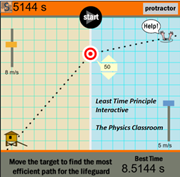 The Least Time Principle is the premise that light always follows the pathway between two locations that takes the least amount of time. This interactive uses the classic analogy of a lifeguard trying to reach a drowning swimmer. The lifeguard can move faster on land than swimming in the ocean, so the pathway of least time is crucial. This interactive is intended for use with the accompanying Student Activity, with lab groups assigned a set of speeds for determining the entry point that produces the fastest time. Through data collection, students can conclude that the ratio of the sines of the angles is inversely related to the ratio of the speeds in each respective medium. In this way, they are producing their own empirical evidence for exploring the validity of Snell’s Law.
The Least Time Principle is the premise that light always follows the pathway between two locations that takes the least amount of time. This interactive uses the classic analogy of a lifeguard trying to reach a drowning swimmer. The lifeguard can move faster on land than swimming in the ocean, so the pathway of least time is crucial. This interactive is intended for use with the accompanying Student Activity, with lab groups assigned a set of speeds for determining the entry point that produces the fastest time. Through data collection, students can conclude that the ratio of the sines of the angles is inversely related to the ratio of the speeds in each respective medium. In this way, they are producing their own empirical evidence for exploring the validity of Snell’s Law.
- Refraction
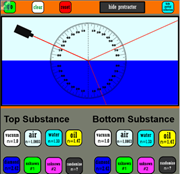 Our mobile-friendly Refraction sim is a great choice for the early phases of a unit on refraction and lenses. You can vary the medium of either the top or bottom substance (or both), fire the laser, and watch how the incident ray bends at the boundary. A protractor tool is provided for accurate measurement of the angles of incidence and refraction. It’s a very visual way to see WHY Snell’s Law works. Don’t miss the companion Student Exercise, an inquiry-based activity that requires learners to figure out which variables to control in order to collect specific data. Students must present their answers in the format of a claim, evidence, and scientific reasoning.
Our mobile-friendly Refraction sim is a great choice for the early phases of a unit on refraction and lenses. You can vary the medium of either the top or bottom substance (or both), fire the laser, and watch how the incident ray bends at the boundary. A protractor tool is provided for accurate measurement of the angles of incidence and refraction. It’s a very visual way to see WHY Snell’s Law works. Don’t miss the companion Student Exercise, an inquiry-based activity that requires learners to figure out which variables to control in order to collect specific data. Students must present their answers in the format of a claim, evidence, and scientific reasoning.
- PhET Simulation: Bending Light
 The scientists at PhET have added some robust tools to their new HTML 5 version of the “Bending Light” simulation. In its basic form, students explore the refraction of light between two media with different indices of refraction. Newer features include Speed, Time, and Light Intensity tools to investigate how speed and wavelength of light changs in different media. View the light as a single laser beam or as a wave (photo above). Finally, click on “Prisms” to see how incident rays behave upon hitting differently-shaped prisms. Can you figure out how to make a rainbow? Don’t blame us….this one is a bit addictive.
The scientists at PhET have added some robust tools to their new HTML 5 version of the “Bending Light” simulation. In its basic form, students explore the refraction of light between two media with different indices of refraction. Newer features include Speed, Time, and Light Intensity tools to investigate how speed and wavelength of light changs in different media. View the light as a single laser beam or as a wave (photo above). Finally, click on “Prisms” to see how incident rays behave upon hitting differently-shaped prisms. Can you figure out how to make a rainbow? Don’t blame us….this one is a bit addictive.
Video and Animations
- PBS Learning Media: The Index of Refraction and Snell’s Law
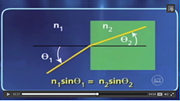 In this multimedia collection, students explore light refraction at the boundary between materials. It includes short videos on refraction and Snell’s Law, two interactive animations, a lab activity to measure the index of refraction, and a video from the National Center for Information and Communications Technologies that illustrates the importance of Snell’s Law in fiber optics. We like this resource because you can choose what you need to differentiate the learning for students of varying capability levels.
In this multimedia collection, students explore light refraction at the boundary between materials. It includes short videos on refraction and Snell’s Law, two interactive animations, a lab activity to measure the index of refraction, and a video from the National Center for Information and Communications Technologies that illustrates the importance of Snell’s Law in fiber optics. We like this resource because you can choose what you need to differentiate the learning for students of varying capability levels.
- Mindset Learn: Refraction of Light
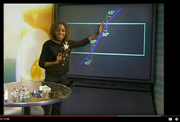 This 18-minute video tutorial is a good choice for students with disabilities or those who are struggling with the content. It was professionally produced by the nonprofit Zenex Foundation and features engaging actors, multiple representations, and liberal use of analogy in explaining the physics of refraction. The diagrams do a nice job of illustrating how the optical density of an object is related to its refractive index. One key takeaway: how to measure and draw a ray diagram of light refracting through a plastic block.
This 18-minute video tutorial is a good choice for students with disabilities or those who are struggling with the content. It was professionally produced by the nonprofit Zenex Foundation and features engaging actors, multiple representations, and liberal use of analogy in explaining the physics of refraction. The diagrams do a nice job of illustrating how the optical density of an object is related to its refractive index. One key takeaway: how to measure and draw a ray diagram of light refracting through a plastic block.
- LearnCoach: Wave Refraction Part 1
https://www.youtube.com/watch?v=487pOjwCauc (Part 1)
https://www.youtube.com/watch?v=kLMURZJjccM&t=202s (Part 2)
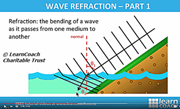 The LearnCoach Charitable Trust is one of New Zealand’s most respected sources of free, video-based tutorials for secondary education. The “Waves Refraction” tutorials address refraction phenomena in terms of the wave nature of light. Part 1 focuses on the basic knowledge required to apply mathematics to problems relating to refraction: 1) Meaning of the Normal line; 2) Identifying and measuring angles of incidence and refraction, 3) Behavior of a light wave when entering a more dense or a less dense medium. This video does an excellent job of reinforcing the concept that frequency remains constant in refraction phenomena; it is the wavelength that changes. Part 2 may have less application in your classroom, but it’s worth a look. It uses water waves moving from deep-to-shallow water to illustrate that waves travel faster in deep water and slower in shallow water. The valuable takeaway is the comparison of the ratio of the wavefronts in deep vs. shallow water. This concept can be extended to help students engage in proportional reasoning in solving refraction problems.
The LearnCoach Charitable Trust is one of New Zealand’s most respected sources of free, video-based tutorials for secondary education. The “Waves Refraction” tutorials address refraction phenomena in terms of the wave nature of light. Part 1 focuses on the basic knowledge required to apply mathematics to problems relating to refraction: 1) Meaning of the Normal line; 2) Identifying and measuring angles of incidence and refraction, 3) Behavior of a light wave when entering a more dense or a less dense medium. This video does an excellent job of reinforcing the concept that frequency remains constant in refraction phenomena; it is the wavelength that changes. Part 2 may have less application in your classroom, but it’s worth a look. It uses water waves moving from deep-to-shallow water to illustrate that waves travel faster in deep water and slower in shallow water. The valuable takeaway is the comparison of the ratio of the wavefronts in deep vs. shallow water. This concept can be extended to help students engage in proportional reasoning in solving refraction problems.
- LearnCoach: Ray Refraction
https://www.youtube.com/watch?v=elG6-ZgO0OI (Part 1)
https://www.youtube.com/watch?v=JQM2ruBYLiU (Part 2)
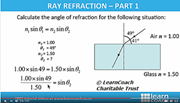 This two-video package addresses refraction phenomena in terms of the particle nature of light. The package includes two videos, described below:
This two-video package addresses refraction phenomena in terms of the particle nature of light. The package includes two videos, described below:
Part 1: If your students are having any struggles setting up Snell’s Law equations, they won’t after watching this 10-minute video. It takes learners step-by-step through each component of Snell’s Law, from how to measure incident and refractive angles through set-up and solution of the related equation. It even explains the calculator function keys needed to accurately evaluate the sine functions.
Part 2: This segment of the “Ray Refraction” package looks at the meaning of total internal reflection and how to use the critical angle to solve a related problem. It takes the learner step-by-step in using Snell’s Law to determine the refractive index of a plastic block when given the critical angle.
- Sixty Symbols: Why Is Light Slower in Glass?
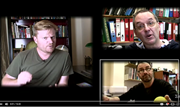 Most students don't have trouble accepting that waves can change speed. But it gets murkier to think about particles of light changing speed -- learners often think of photon speed as constant (i.e., the "speed of light"). This set of dual videos features two Nottingham University professors presenting both a classical and quantum view of what happens when light traveling in air interacts with matter. You won't need to grapple with the math of quantum mechanics -- just open your mind to the possible explanations of why light is slower when it hits the boundary between air and glass.
Most students don't have trouble accepting that waves can change speed. But it gets murkier to think about particles of light changing speed -- learners often think of photon speed as constant (i.e., the "speed of light"). This set of dual videos features two Nottingham University professors presenting both a classical and quantum view of what happens when light traveling in air interacts with matter. You won't need to grapple with the math of quantum mechanics -- just open your mind to the possible explanations of why light is slower when it hits the boundary between air and glass.
- Reflection and Refraction of Colored Light in Water/Air Surface
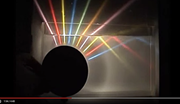 This 5-minute YouTube video can help students visualize the relationship between light reflection and refraction as different colors of filtered light reach the boundary of water and air. The apparatus used was a Leybold 464-261, a device used to demonstrate refraction and reflection phenomena as a light beam crosses the boundary from water to air at various angles. Watch what happens when the incident angle is greater than the critical angle (total internal reflection).This is a highly visual way to build accurate concepts of what happens when light strikes a boundary.
This 5-minute YouTube video can help students visualize the relationship between light reflection and refraction as different colors of filtered light reach the boundary of water and air. The apparatus used was a Leybold 464-261, a device used to demonstrate refraction and reflection phenomena as a light beam crosses the boundary from water to air at various angles. Watch what happens when the incident angle is greater than the critical angle (total internal reflection).This is a highly visual way to build accurate concepts of what happens when light strikes a boundary.
Reference Materials
- Refractive Index Database
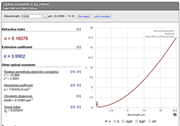 This comprehensive database, published by refractiveindex.org, provides a treasure trove of free information on the refractive indices of inorganic and organic materials, glasses, alloys, liquid crystals, semiconductors…..and the human liver and colon. For advanced students, it provides additional optical constants, as well as group velocity and group index values, absorption coefficients, and more. The material shown in the photo here is silver.
This comprehensive database, published by refractiveindex.org, provides a treasure trove of free information on the refractive indices of inorganic and organic materials, glasses, alloys, liquid crystals, semiconductors…..and the human liver and colon. For advanced students, it provides additional optical constants, as well as group velocity and group index values, absorption coefficients, and more. The material shown in the photo here is silver.
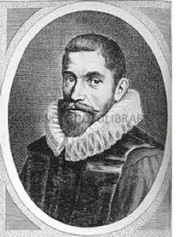 Biography: Willebrord van Royen Snell
Biography: Willebrord van Royen Snell
Did you know that the man whose name graces one of the most important laws of optics did not ever publish it? Did you also know that Snell believed the Earth was the center of the solar system? This web page – authored by John O’Connor and Edmund Robertson, School of Mathematics and Statistics at the University of St. Andrews, Scotland – provides an engaging and very human glimpse of Willebrord Snell and his contributions during his short life in the 17th Century.
- Fundamentals of Photonics: Basic Geometrical Optics
 This free-access textbook published was published by SPIE, the International Society for Optics and Photonics. It offers an introduction to the basics of light reflection and refraction, and applications of geometrical optics in mirrors, lenses, and fiber optics. It discusses the dual nature of light as both particle and wave; explores the Laws of Reflection and Refraction and their applications; illustrates ray-tracing techniques; and explores total internal reflection. But it goes further than most high school textbooks to cover light dispersion, collimated light, minimum angle of deviation for a prism, Gaussian optics, thick and thin lenses, numerical aperture applications, and the Lensmaker’s Equation.
This free-access textbook published was published by SPIE, the International Society for Optics and Photonics. It offers an introduction to the basics of light reflection and refraction, and applications of geometrical optics in mirrors, lenses, and fiber optics. It discusses the dual nature of light as both particle and wave; explores the Laws of Reflection and Refraction and their applications; illustrates ray-tracing techniques; and explores total internal reflection. But it goes further than most high school textbooks to cover light dispersion, collimated light, minimum angle of deviation for a prism, Gaussian optics, thick and thin lenses, numerical aperture applications, and the Lensmaker’s Equation.
Labs and Investigations
- The Physics Classroom, The Laboratory, Lab RL1 - Refraction Action
This lab consists of three short activities that lead students to an understanding of when light refracts, why light refracts, and when light doesn't refract.
- The Physics Classroom, The Laboratory, Lab RL2 - Direction of Bending
Students analyze the bending of laser light at two boundaries and reason towards a rule that describes the direction that light bends at a boundary between two materials.
- The Physics Classroom, The Laboratory, Lab RL4 - How Much?
Students collect a set of data showing the dependence of the angle of refraction upon the angle of incidence and use graphical methods to derive Snell's Law from the data.
- The Physics Classroom, The Laboratory, Lab RL5 - The Unknown n
Students trace the path of light through a transparent material and apply Snell's Law to the refraction boundaries in order to determine the index of refraction of the material.
Link: http://www.physicsclassroom.com/lab/refrn/RLlabs.cfm
Demonstration Ideas
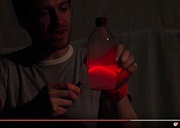 Brit Lab: How Does Light Bend?
Brit Lab: How Does Light Bend?
Mechanical engineer Rob Bell does three simple demonstrations to illustrate the concepts of refraction and total internal reflection. Each demo can be done in the classroom with inexpensive materials found in the local grocery or hardware store.
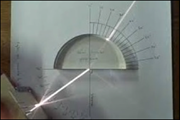 Quantum Boffin: Snell’s Law of Refraction
Quantum Boffin: Snell’s Law of Refraction
This short video demonstrates light being shone through a glass block shaped like a half circle. Underneath the glass, a paper template allows the demonstrator to train the light to accurate angles of incidence. Watch the refraction as the light source is moved in 5-degree increments.
Minds On Physics Internet Modules:
The Minds On Physics Internet Modules are a collection of interactive questioning modules that target a student’s conceptual understanding. Each question is accompanied by detailed help that addresses the various components of the question.
- Refraction and Lenses, Ass’t RL1 - Meaning and Cause of Refraction
- Refraction and Lenses, Ass’t RL2 - Light Speed and Refraction
- Refraction and Lenses, Ass’t RL3 - Optical Density, Index of Refr'n, and Refr'n
- Refraction and Lenses, Ass’t RL4 - Snell's Law
Concept Building Exercises:
- The Curriculum Corner, Refraction and Lenses, Light Refraction
- The Curriculum Corner, Refraction and Lenses, Direction of Bending
- The Curriculum Corner, Refraction and Lenses, Snell's Law
Problem-Solving Exercises:
- The Calculator Pad, Refraction and Lenses, Problems #1 - #12
Link: http://www.physicsclassroom.com/calcpad/refrn/problems
Science Reasoning Activities:
- Science Reasoning Center, Refraction Section, Reflection and Transmission
- Science Reasoning Center, Refraction Section, Snell's Law
Link: http://www.physicsclassroom.com/reasoning/refraction
Real Life Connections:
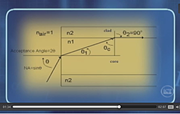 PBS Learning Media: ICT Center – Fiber Optics
PBS Learning Media: ICT Center – Fiber Optics
This 2-minute video illustrates with great clarity how Snell’s Law is used in calculating numerical aperture measurements in fiber optic systems. It may interest your students to know that many fields, such as fiber optics, offer career opportunities for people with a physics background, but do not require doctoral degrees.
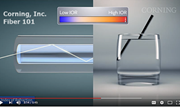 Corning Inc. – Fiber 101
Corning Inc. – Fiber 101
Without being too commercial, this 6-minute video explores the basics of optical fiber, its composition, and its capabilities. Animations clearly show how light rays undergo total internal reflection within the core of the cable. Fiber optics is a field of promise for both engineers and people with 4-year degrees.
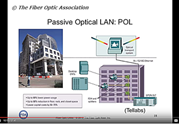 The Fiber Optic Association: Where are the Jobs in Fiber Optics?
The Fiber Optic Association: Where are the Jobs in Fiber Optics?
Here you’ll find a 20-minute exploration of jobs in fiber optics that do not require a doctorate but DO require knowledge of physics. Wireless communications come to mind immediately, but this video also looks at energy, security, manufacturing, and entertainment. Not the glitziest video, but solid information.
Elsewhere on the Web:
- University of Virginia Department of Physics: Refraction of Light Home Labs
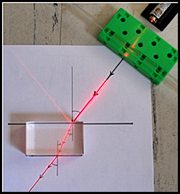 This page offers a set of six inquiry-based investigations that can be easily set up at home or in the high school physics classroom with readily-obtainable materials. It was developed as part of a professional development course for K-12 science teachers, but the activities could be easily adapted to the introductory physics class. The problem sets that accompany each investigation are designed to build conceptual understanding. Although little mathematics is introduced, the scientific reasoning required of students should prove challenging.
This page offers a set of six inquiry-based investigations that can be easily set up at home or in the high school physics classroom with readily-obtainable materials. It was developed as part of a professional development course for K-12 science teachers, but the activities could be easily adapted to the introductory physics class. The problem sets that accompany each investigation are designed to build conceptual understanding. Although little mathematics is introduced, the scientific reasoning required of students should prove challenging.
Standards:
A. Next Generation Science Standards (NGSS)
Crosscutting Concepts
Patterns
- Macroscopic patterns are related to the nature of microscopic and atomic-level structure.
- Mathematical representations are needed to identify some patterns.
Structure and Function
- The functions and properties of natural and designed objects can be inferred from their overall structure, the way their components are shaped and used, and the molecular substructures of their various materials.
Science and Engineering Practices
Practice #2: Developing and Using Models
- Develop and/or use a model based on evidence to illustrate and/or predict the relationships between systems or between components of a system.
- Develop and/or use a model (including mathematical and computational) to generate data to support explanations, predict phenomena, analyze systems, and/or solve problems.
Practice #3: Analyzing and Interpreting Data
- Analyze data using tools, technologies, and/or models (e.g. computational, mathematical) in order to make valid and reliable scientific claims.
- Compare and contrast various types of data sets (e.g., self-generated, archival, computer-generated), to examine consistency of measurements and observations.
Practice #4: Using Mathematics and Computational Thinking
- Create and/or revise a computational model or simulation of a phenomenon, designed device, process, or system.
- Use mathematical, computational, and/or algorithmic representations of phenomena or design solutions to describe and/or support claims and/or explanations.
Practice #5: Constructing Explanations
- Construct and revise an explanation based on valid and reliable evidence obtained from a variety of sources (including students’ own investigations, models, theories, simulations) and the assumption that theories and laws that describe the natural world operate today as they did in the past and will continue to do so in the future.
Practice #8: Obtaining, Evaluating, and Communicating Information: High School
- Critically read scientific literature adapted for classroom use to determine the central ideas or conclusions and/or to obtain scientific and/or technical information to summarize complex evidence, concepts, processes, or information presented in a text.
• Gather, read, and evaluate scientific and/or technical information from multiple authoritative sources, assessing the evidence and usefulness of each source.
The Nature of Science
- Theories and laws provide explanations in science, but theories do not with time become laws or facts.
- Laws are statements or descriptions of the relationships among observable phenomena